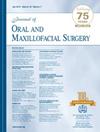Association Between Type of Residency Interview, Virtual Versus In-Person, and Distance From Applicants' Dental School to Oral and Maxillofacial Surgery Program Matched: Report From the American Association of Oral and Maxillofacial Surgeons Committee on Education and Training
IF 2.6
3区 医学
Q2 DENTISTRY, ORAL SURGERY & MEDICINE
引用次数: 0
Abstract
Background
Oral and maxillofacial surgery (OMS) residency interviews for the 2021 match during the Covid-19 pandemic were near universally virtual in contrast to in-person interviews of prior years. In deciding whether to conduct in-person or virtual interviews, it is important for residency programs to understand the association of interview type on the distance between dental school attended and the program to which the applicant matched.
Purpose
The study purpose was to measure the association between the type of residency interview conducted and the distance from the dental school attended to the program which the applicant matched.
Study design, setting, sample
A retrospective cohort study was designed using National Matching Services Incorporated data of all applicants to OMS residency programs who matched the year following dental school between 2019 and 2021. Those who did not match the same year as dental school graduation were excluded.
Predictor variable
The predictor variable was interview type. Match years 2019 and 2020 were coded as in-person and match year 2021 coded as virtual.
Outcome
The main outcome variable was the straight-line distance in miles between dental school attended and residency matched calculated from geographic coordinates.
Covariates
There were no covariates.
Analyses
Wilcoxon signed-rank test was performed to determine if an association existed between the interview type and the distance. The significance level was set at a P value of ≤ .05.
Results
The final sample was composed of 418 applicants who matched into OMS residency between 2019 and 2021. There were 277 (66%) and 141 (34%) applicants in the in-person and virtual interview groups, respectively. The mean distances between the dental school and the resident program for the in-person and virtual applicant pools were 633.22 miles (SD = 681.12 miles) and 630 miles (SD = 710.21 miles) respectively, (P value = .6).
Conclusions and relevance
While distance between dental school and residency program may play an important role in the match, that distance did not have any statistically significant association with the type of interview.
来自美国口腔颌面外科医生教育和培训委员会的报告:住院医师面试类型、虚拟与面对面、申请人牙科学校到口腔颌面外科项目的距离之间的关系。
背景:与前几年的面对面访谈相比,2019冠状病毒病大流行期间2021年比赛的口腔颌面外科(OMS)住院医师访谈几乎普遍采用虚拟方式。在决定是否进行面对面或虚拟面试时,重要的是住院医师项目要了解面试类型与申请人所就读的牙科学校和所匹配的项目之间的距离的关系。目的:本研究的目的是测量住院医师面谈的类型与申请人所就读的牙科学校的距离之间的关系。研究设计、环境、样本:使用国家匹配服务公司(National Matching Services Incorporated)的数据设计了一项回顾性队列研究,该数据来自2019年至2021年牙科学校毕业后一年OMS住院医师项目的所有申请人。与牙科学校毕业年份不符者排除在外。预测变量:预测变量为面试类型。2019年和2020年比赛年被编码为面对面比赛年,2021年比赛年被编码为虚拟比赛年。结果:主要结果变量为从地理坐标计算的牙科学校和住院医师之间的直线距离(英里)。协变量:没有协变量。分析:采用Wilcoxon符号秩检验来确定访谈类型与距离之间是否存在关联。P值≤0.05为显著性水平。结果:最终样本由418名申请人组成,他们在2019年至2021年期间匹配到OMS居住。现场面试组和虚拟面试组分别有277人(66%)和141人(34%)。牙科学校和住院医师项目的实际申请者和虚拟申请者之间的平均距离分别为633.22英里(SD = 681.12英里)和630英里(SD = 710.21英里),(P值= 0.6)。结论和相关性:虽然牙科学校和住院医师项目之间的距离可能在匹配中起重要作用,但距离与面试类型没有任何统计上的显著关联。
本文章由计算机程序翻译,如有差异,请以英文原文为准。
求助全文
约1分钟内获得全文
求助全文
来源期刊

Journal of Oral and Maxillofacial Surgery
医学-牙科与口腔外科
CiteScore
4.00
自引率
5.30%
发文量
0
审稿时长
41 days
期刊介绍:
This monthly journal offers comprehensive coverage of new techniques, important developments and innovative ideas in oral and maxillofacial surgery. Practice-applicable articles help develop the methods used to handle dentoalveolar surgery, facial injuries and deformities, TMJ disorders, oral cancer, jaw reconstruction, anesthesia and analgesia. The journal also includes specifics on new instruments and diagnostic equipment and modern therapeutic drugs and devices. Journal of Oral and Maxillofacial Surgery is recommended for first or priority subscription by the Dental Section of the Medical Library Association.
 求助内容:
求助内容: 应助结果提醒方式:
应助结果提醒方式:


